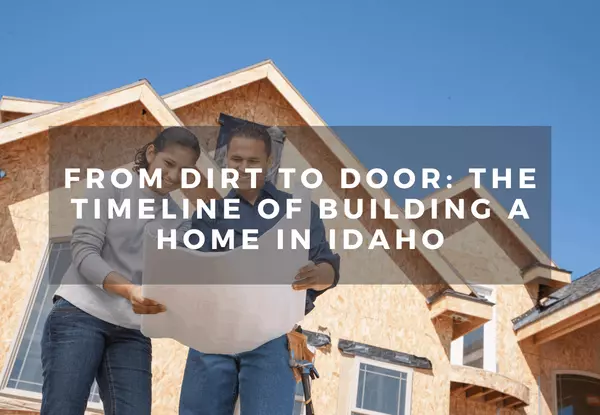Home Inspection Guide for Treasure Valley Properties: What Buyers Need to Know Before Closing

Why Inspections Matter More in Treasure Valley Than You Think
When you're buying a home in the Treasure Valley—whether it's in Boise, Eagle, Meridian, Nampa, or Caldwell—there’s more at stake in a home inspection than just checking a few boxes. This isn’t just a formality; it’s your last line of defense before closing on one of the biggest investments of your life.
But here's the thing: not all inspections are created equal, and in Idaho, we’ve got some unique property factors that buyers need to be aware of. From expansive clay soils that affect foundations to pressurized irrigation systems, septic tanks, and private wells, our area brings specific regional risks and nuances that every buyer should understand.
This guide gives you a full breakdown of what to inspect, what red flags to watch for, and how to navigate the process like a pro—especially if you’re buying from out of state.
Step 1: Start with a Full Residential Home Inspection
A standard home inspection in Treasure Valley typically includes:
-
Roof
-
HVAC
-
Plumbing
-
Electrical
-
Foundation & Structure
-
Attic & Insulation
-
Interior finishes and function
A great local inspector doesn’t just check items—they explain them. In my transactions, I always recommend inspectors who specialize in Idaho-specific issues (we’ll dive into those next).
Foundation Types and Soil Considerations in Treasure Valley
Expansive Soils and Concrete Movement
Much of Treasure Valley—especially areas like Kuna, Nampa, and parts of Caldwell—sits on expansive clay soils. These soils swell when wet and shrink when dry, putting pressure on concrete slabs, footings, and walkways.
What to inspect:
-
Foundation cracks (especially stair-step cracks in stem walls)
-
Heaving or settling in patios or driveways
-
Sloping floors or door frames that don’t square up
-
Cracks above windows or in drywall corners
Curtis Pro Tip: A few minor settlement cracks can be normal. But if doors are sticking or cracks are wider than 1/4", we may bring in a structural engineer for a second opinion—especially on higher-end or acreage homes.
Crawlspaces and Moisture
In many older homes and even some newer ones, we still see vented crawlspaces rather than slabs. These can be a hotspot for:
-
Moisture and mold issues
-
Rodent or insect access
-
Ductwork or insulation problems
What to inspect:
-
Vapor barrier coverage
-
Evidence of standing water
-
Insulation integrity and secure ductwork
Roofs, Siding, and Exterior Wear in Idaho’s Climate
Weathering from Sun, Snow, and Wind
Our four-season climate means your roof, windows, and siding take a beating—from 100° summers to freezing winters.
Roof inspection focus:
-
Missing or curling shingles
-
Flashing failures near chimneys or valleys
-
Ice dam damage (especially in foothill homes)
Siding inspection focus:
-
Cracking, peeling paint, or water intrusion on older lap siding
-
Loose vinyl siding in high wind areas
-
Caulking around windows and joints
Irrigation Systems and Pressurized Water
Understanding Idaho’s Irrigation Infrastructure
Many subdivisions in Meridian, Nampa, and Kuna include pressurized irrigation systems, separate from city water. These systems run seasonally and are managed by local irrigation districts.
Key things to inspect:
-
Backflow device condition and location
-
Controller function (especially if it’s WiFi-enabled)
-
Zone function and pressure
Red Flag: A home with dead landscaping during irrigation season may have a non-working pump, broken backflow, or inactive service.
Shared Community Systems
Some neighborhoods—especially on the edge of town—share irrigation pumps or filtration systems. Make sure you understand:
-
Who maintains the system
-
How often it’s serviced
-
Whether it’s HOA-managed or homeowner-responsible
Septic Systems and Private Wells: What to Know in Outlying Areas
Septic Tanks
Homes in Star, Middleton, South Nampa, and Eagle Foothills often operate on septic systems. These require separate inspection and pumping before sale.
What’s included in a septic inspection:
-
Locate and uncover tank
-
Pump tank and inspect baffles
-
Perform flow test
-
Check drain field saturation
Curtis Insight: A backed-up or saturated drain field can kill a deal. We recommend ordering this inspection early if the home has a septic system—so we can make decisions fast.
Private Wells
Private wells must be tested for water quality and flow rate. Lenders often require this for financing.
What to inspect:
-
Gallons per minute (GPM) test
-
Pressure tank function
-
Bacteria, nitrate, and arsenic levels
-
Well cap security and depth report
Red Flag: Many older wells don’t have updated caps or are poorly sealed. This can allow insects or contaminants inside.
HVAC and Energy Systems in Treasure Valley Homes
HVAC Performance
We see a mix of gas furnaces, electric heat pumps, and hybrid systems in the Valley. What’s important is:
-
Age of system (10–15 years is average life)
-
Filter condition (indicates maintenance)
-
Proper airflow and temperature split
If the system’s over 15 years old, we may negotiate a home warranty or seller credit.
Insulation and Energy Efficiency
Homes built after 2012 typically meet HERS and Energy Star standards. For older homes:
-
Check attic insulation depth
-
Look for duct leakage
-
Evaluate window seals and UV ratings
Curtis Tip: Many buyers can qualify for rebates if they add insulation or upgrade HVAC post-purchase. I help my clients access those local programs.
Additional Specialty Inspections to Consider
Radon Testing
Boise and Eagle have moderate radon levels in some areas. It’s a simple 48-hour test that can provide peace of mind—and mitigation systems are affordable.
Mold and Air Quality
If the inspector notes high moisture, musty smells, or visible spots, we’ll bring in a licensed mold assessor.
Pool and Spa Inspection
High-end homes in Eagle, Legacy, or SpurWing may include private pools or spas. These require:
-
Function check of pumps and heaters
-
Leak test
-
Condition of coping, tile, and plaster
Inspection Timelines and Negotiations in Idaho
Inspection Period in a Standard Offer
Most offers in Idaho include a 7–10 business day inspection period, unless otherwise negotiated. This is when buyers:
-
Conduct inspections
-
Review reports
-
Request repairs or credits
-
Decide to proceed or cancel
Curtis’ Strategy for Inspection Repair Requests
I always coach clients to focus on health, safety, and functionality—not cosmetics. My approach:
-
Prioritize repairs (roof leaks, HVAC, foundation)
-
Get quotes from local contractors quickly
-
Draft repair addendums that protect your future value
Curtis Reminder: A home doesn’t have to be perfect—but it should be safe, sound, and serviceable.
Final Thoughts: Protecting Your Investment Starts With Inspection
Buying a home in Treasure Valley is exciting—but skipping or skimping on the inspection is the fastest way to regret a purchase. Whether you’re buying a 1980s ranch in Caldwell or a 2023 luxury home in Eagle, every property needs a close look with a local lens.
As your agent, I don’t just help you find the right home—I help you make sure it’s the right condition and price. I’ll guide you through inspection options, help coordinate with vendors, and negotiate the outcomes that protect your investment long-term.
Looking at homes in Treasure Valley and want expert support on inspections and property health?
📲 Call or text Curtis Chism at (208) 510-0427
📥 Ready to relocate remotely? Download our Boise Relocation Guide
Categories
Recent Posts










